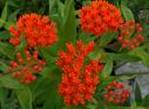Scientific Classification:
|
Other Common Names:
The other common names for the herb Pleurisy root are Butterfly Weed, Canada Root, Silkweed, Tuber Root, Chigger weed and Wind Root.History



Description


Range
Though pleurisy root is a native of North America it is widely distributed throughout Ontario to Minnesota, southward to Florida, Texas, and Arizona.
Habitat
Pleurisy root thrives best in dry fields and pastures. Thus butterfly weed which is a North American native perennial occurs in dry/rocky open woods, glades, prairies, fields and roadsides.
Cultivation
Pleurisy root is native to the southern US. The root is unearthed in spring. This is one of the prettiest medicinals you can grow but which cannot be improved upon by breeding. Pleurisy root is drought tolerant and they should be collected in autumn, when well stored with sustenance for the winter. Plant 1 foot apart and grow to 2 feet tall. Persistently deprive the tuberous roots of green growth above ground and they will at length wither and die. Begin cutting before the first flowers mature, and repeat as often as new shoots put forth. Dry salt applied to the shorn surfaces will check new growth. The root is unearthed in spring. Easily grown in average, dry to medium, well-drained soils in full sun. Drought tolerant. Does well in poor, dry soils. New growth tends to emerge late in the spring. Plants are easily grown from seed, but are somewhat slow to establish and may take 2-3 years to produce flowers. Mature plants may freely self-seed in the landscape if seed pods are not removed prior to splitting open. Butterfly weed does not transplant well due to its deep taproot, and is probably best left undisturbed once established.
Flowering Season
The corymbs of deep yellow and orange flowers of the pleurisy root are in bloom between June to September.Pests and Diseases
No serious insect or disease problems. Crown rot can be a problem in wet, poorly drained soils. Susceptible to rust and leaf spot.
Parts Used
 |
The roots and the rhizomes of the pleurisy plant are the most commonly used part of the plant for its commercial and medicinal applications. |
Medicinal Applications
- Pleurisy root is used to treat lung disorder, pain when breathing, pneumonia, chest congestion, colds, flu, bronchitis, etc.
- Pleurisy root is also used to promote sweating and opening of the lung capillaries, allowing more moisture to enter the lungs to thin the mucus, which can then be expelled more easily.
- It acts as an antispasmodic, diaphoretic, expectorant, tonic, carminative and mildly cathartic.
- It has also been used with great advantage in diarrhoea, dysentery and acute and chronic rheumatism, in low typhoid states and in eczema.
- It is claimed that the drug may be employed with benefit in flatulent colic and indigestion, but in these conditions it is rarely used.
- Pleurisy also acts as an emetic and purgative.
- It is often combined with Angelica and Sassafras for producing perspiration in fever and pleurisy and for equalizing the circulation of the blood.
- Constituents in pleurisy mimic the action of estrogen in the body, making the herb useful specifically in bringing on delayed menstruation, or for use as an aborifacient.
- The roots of this plant were ground into a powder and either brewed as a tea or made into poultices for open wounds and sores.
- Consumption of the tea increases bronchial dilation and drainage of the lymph system.
Folklore and Myths
The Indians of several regions brewed a tea from the leaves to induce vomiting in certain rituals. The Asclepias were named for Aesculapius, who is said to have learned his knowledge of healing from an apprenticeship to Cheiron, the centaur who's herbal and medical skills came directly from Apollo.


